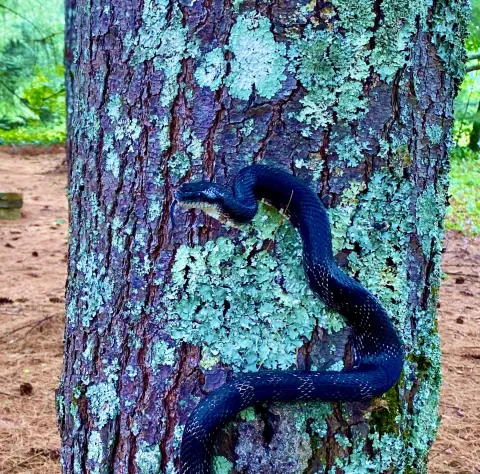The Snake Heebie-Jeebies

By Steve Roark
Volunteer for Cumberland Gap National Historical Park
I don’t know of anybody that doesn’t have a fear response when they stumble across a snake in the woods or the tool shed. The usual reaction is to jump back and express a four-letter metaphor. I do it myself, even though I know that snakes are mostly harmless, and the poisonous ones rarely strike a human unless really provoked. But all that knowledge goes out the window when I first see a snake, and I’m instantly in a “get out of here” mode.
So what is it about snakes that generate such a universal fear? There is endless debate on the subject in the science world, and it generally comes down to two thoughts: is the fear a learned response or are we genetically hard wired to fear slithery things? There’s been lots of research trying to figure this out, and the results are pretty gray. My best spin on the matter is that it may be a little of both. Very young children usually do not fear snakes at first, and yet they can pick out a snake in the background of a photo quicker than anything else. They also show a predisposition to learn to fear snakes from a bad experience or being exposed to other people’s fear reaction. Wild-born monkeys fear snakes while those raised in a lab do not. They’ll reach over a life-like rubber snake and get a peanut without a second thought. But when the lab monkey is shown a video of a wild monkey reacting in fear to a snake, the lab monkey then became afraid. Sounds like snake fear is learned. But when the video was altered to show a monkey reacting in fear to a flower rather than a snake, the lab monkey (who had never seen a flower or a snake) did not develop a fear of flowers. So now what? The answer may be that fear of snakes is instinctive, but must be triggered by something… a bad experience, being told scary snake stories, or television/movie drama. And once triggered, the instinct is locked in.
The strangeness of a snake probably has something to do with fearing them. No legs, cold blooded, scaly skin, beady eyes, tongue lashing out; they are unique creatures. In a survey the two things that people fear is that some snakes are poisonous and that they are able to remain unseen. We do have poisonous snakes in our area (copperheads and rattlers), and they are excellent in the art of camouflage and stealth. I rarely see snakes in all the stomping around I do in the woods, but I have almost stepped on a copperhead a couple of times because they blend in so well with the leaves on the ground.
Snakes do not live up to the hype often given them. They are not out to get us; the vast majority are not poisonous; the poisonous ones only strike as a last resort (usually being stepped on); if you are bitten, only one in 1000 snake bites result in death. They play an important role in keeping mice and rat populations down. My wife has told me that she would tolerate a snake in the house if they would get rid of mice. So go ahead and fear snakes a little, you can’t help it. But don’t let that fear grow to where it prevents you from enjoying the outdoors. If you see one, wait for the adrenaline rush to settle and simply give them some distance. Don’t kill them just because they are snakes, as they belong here too.
- Log in to post comments